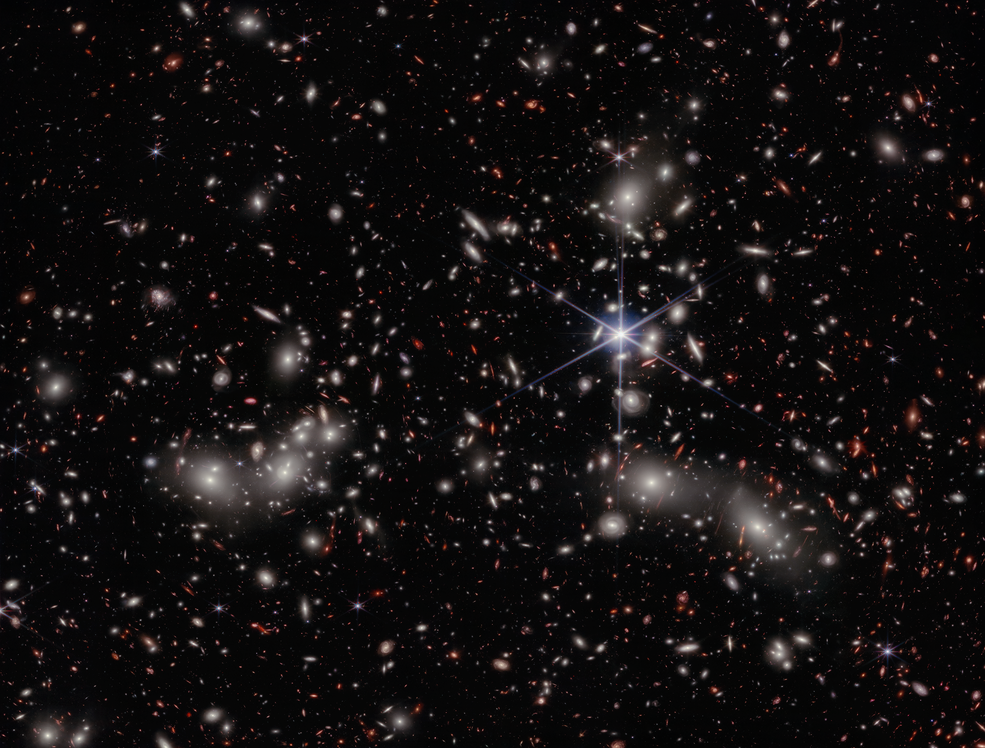A feature of a never-seen-before detail in a region of space called Pandora’s Cluster (Abell 2744) has been presented by astronomers with the new deep field image obtained from NASA’s James Webb Space Telescope

Astronomers estimate 50,000 sources of near-infrared light are represented in this image from NASA’s James Webb Space Telescope. Their light has traveled through varying distances to reach the telescope’s detectors, representing the vastness of space in a single image. Image Credits: NASA, ESA, CSA, I. Labbe (Swinburne University of Technology), and R. Bezanson (University of Pittsburgh). Image processing: Alyssa Pagan (STScI)
The view of Webb shows three massive clusters of galaxies that are merging to develop a mega cluster. The integrated mass of the galaxy clusters makes a natural magnification effect of gravity, a strong gravitational lens, enabling much farther galaxies in the early universe to be seen by using the cluster like a magnifying glass.
Only the central core of Pandora has previously been studied in depth by NASA’s Hubble Space Telescope. By integrating Webb’s strong infrared instruments with an extensive mosaic view of the region’s several areas of lensing, astronomers aimed to obtain a balance of depth and breadth that would set the stage for a new frontier in the study of galaxy evolution and cosmology.
The ancient myth of Pandora is about human curiosity and discoveries that delineate the past from the future, which I think is a fitting connection to the new realms of the universe Webb is opening up, including this deep-field image of Pandora’s Cluster.
Rachel Bezanson, Astronomer, University of Pittsburgh
Bezanson is a co-principal investigator on the “Ultradeep NIRSpec and NIRCam ObserVations before the Epoch of Reionization” (UNCOVER) program to learn about the region.
When the images of Pandora’s Cluster first came in from Webb, we were honestly a little star struck. There was so much detail in the foreground cluster and so many distant lensed galaxies, I found myself getting lost in the image. Webb exceeded our expectations.
Rachel Bezanson, Astronomer, University of Pittsburgh in Pennsylvania
The Pandora Cluster’s new view stitches around four Webb snapshots collectively into one panoramic image, thereby showing approximately 50,000 sources of near-infrared light.
Besides magnification, gravitational lensing deforms the view of distant galaxies so that they look very different to those in the foreground. The galaxy cluster “lens” appears to be so huge that it warps the fabric of space itself, enough that light from distant galaxies that passes via this warped space also takes on a warped appearance.
Astronomer Ivo Labbe of the Swinburne University of Technology in Melbourne, Australia, co-principal investigator on the UNCOVER program, stated that in the lensing core to the lower right in the Webb image, which has not been imaged by Hubble, Webb disclosed hundreds of faraway lensed galaxies that seem like faint arced lines in the image. More and more of them are seen by zooming in on the area.
Pandora’s Cluster, as imaged by Webb, shows us a stronger, wider, deeper, better lens than we have ever seen before. My first reaction to the image was that it was so beautiful, it looked like a galaxy formation simulation. We had to remind ourselves that this was real data, and we are working in a new era of astronomy now.
Ivo Labbe, Astronomer, Swinburne University of Technology
The UNCOVER group made use of Webb’s Near-Infrared Camera (NIRCam) to catch the cluster, with exposures lasting around 4 to 6 hours for a sum of around 30 hours of observation.
The next step is to carefully go through the imaging data and choose galaxies for follow-up observation with the Near-Infrared Spectrograph (NIRSpec). This will offer accurate distance measurements, together with other detailed information regarding the lensed galaxies’ compositions.
This offers deep insights into the early era of galaxy evolution and assembly. The UNCOVER team anticipates making such NIRSpec observations in the summer of 2023.
In the meantime, all of the NIRCam photometric data has been released publicly so that other astronomers can become familiar with it.
“We are committed to helping the astronomy community make the best use of the fantastic resource we have in Webb. This is just the beginning of all the amazing Webb science to come,” stated UNCOVER co-investigator Gabriel Brammer of the Niels Bohr Institute’s Cosmic Dawn Center at the University of Copenhagen.